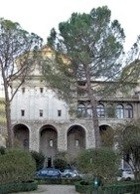

Matteo di Giovannello, il Gattapone was first documented in 1341 in his native Gubbio. In 1349, he was documented as “mensurator e geometra” in relation to the construction of the Palazzo del Podestà there (see below). In this and other cases, he seems to have acted as project manager: he is never referred to as an architect, although he is often credited with the design of the buildings with which he was associated.
Il Gattapone was closely linked to the papal legate, Cardinal Gil Albornoz from 1362, when he was appointed as “offitialeni et suprastantem fabbrice rocche” of the Rocca di Spoleto (see below). He continued to be closely associated with this project until 1370.
Il Gattapone witnessed a donation of books by Cardinal Albornoz to the Collegio di Spagna, Bologna. He also witnessed the contract that commissioned work on the fabric of the college from four Bolognese craftsmen, and received a number of subsequent payments in relation to this project. The associated documents describe him as: “soprastante”; “magister, factor”; and “ingegnerius”.
After the death of Cardinal Albornoz in 1367, il Gattapone continued to work on the fortress at Spoleto. He also worked for the cardinal’s heirs in his burial chapel in San Francesco, Assisi (see below) and at Bologna. He later worked for Gérald du Puy, Abbot of Marmoutier, who was installed in Governor of Perugia in 1372 by his uncle, Pope Gregory XI (see below). Matteo di Giovannello, il Gattapone is recorded in Orvieto in 1373, when he advised on the construction of a second fortress near Porta Maggiore. However, this was never built.
A “magistro Mactheo” is documented in Gubbio in 1380-3. This is usually thought to refer to il Gattapone, who probably died of plague in 1383.
Gubbio
Palazzo dei Consoli (1322-42)
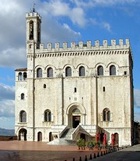
Palazzo del Podestà (1349)
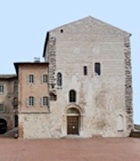
Assisi
Work at San Francesco
In his will, Cardinal Albornoz left a number of gifts for San Francesco, including 1,000 florins for the reconstruction of the infirmary in the west wing of the Sacro Convento di San Francesco. The management of this project is attributed to il Gattapone.
In 1367, the heirs of Cardinal Albornoz paid him for the repair of the Cappella di Santa Caterina, in which the cardinal was temporarily buried.
Narni
Rocca (1367-78)
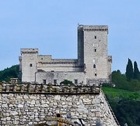
Palazzo dei Priori (14th century)
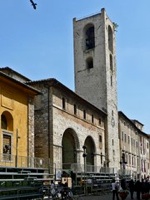
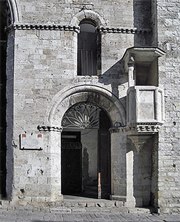
The two huge vaults of the loggia on the ground floor of Palazzo dei Priori, together with the portal and the Loggetta del Banditore between the right arch and the Torre Civica (illustrated in detail above, to the right), are attributed to il Gattapone. The presence of the Orsini arms [above the central pilaster of the loggia or on the facade?] suggests that it was commissioned in 1373-7, when the Orsini held Narni for the papacy.
Perugia
Fortezza di Porta Sole (1372-5)
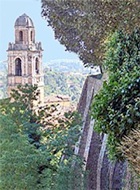
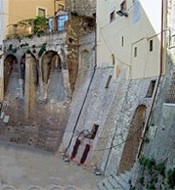
Terrace to the north Terrace to the east
under what is now Piazza Rossi Scotti in Piazza Piccinino
The papal legate Gérard du Puy, Abbot of Marmoutier, (known to the Italians as “Monmaggiore”) commissioned the Fortezza di Porta Sole to secure papal control of Perugia. Il Gattapone is documented in relation to the project in 1374, when he was mandated to secure the economic assistance of the Commune of Assisi. He was referred to as “generalis offitialis operum cictadelle”and “generalis superstite cictadelle”.
The fortress was connected by fortified corridors to Palazzo dei Priori (which the legate had commandeered) and to a smaller fortress at Porta Sant’ Antonio. A third corridor was planned to link it to another fortress at Porta di Sant’ Angelo. Most of these structures were demolished in 1376 when the Perugians revolted and expelled the legate from the city. However, the residences in the main citadel survived until 1463, when they were destroyed by fire.
Cloister of Santa Giuliana (ca. 1375)
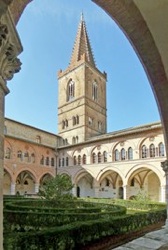
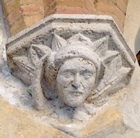
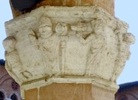
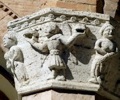
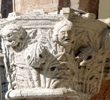

Some of the other interesting capitals in the cloister are illustrated above.
Spoleto
Rocca di Spoleto (1359-70)
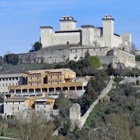
In 1362, Cardinal Albornoz nominated il Gattapone as “offitialeni et suprastantem fabbrice rocche”, with wide powers to requisition work on the site. Construction must have been advanced by 1367, when the first papal castellan, the Spaniard Pedro Consalvo, was appointed a few months after Cardinal Albornoz died. The last recorded payment to il Gattapone in this context was made in 1370.
Palazzo della Signoria (14th century)
